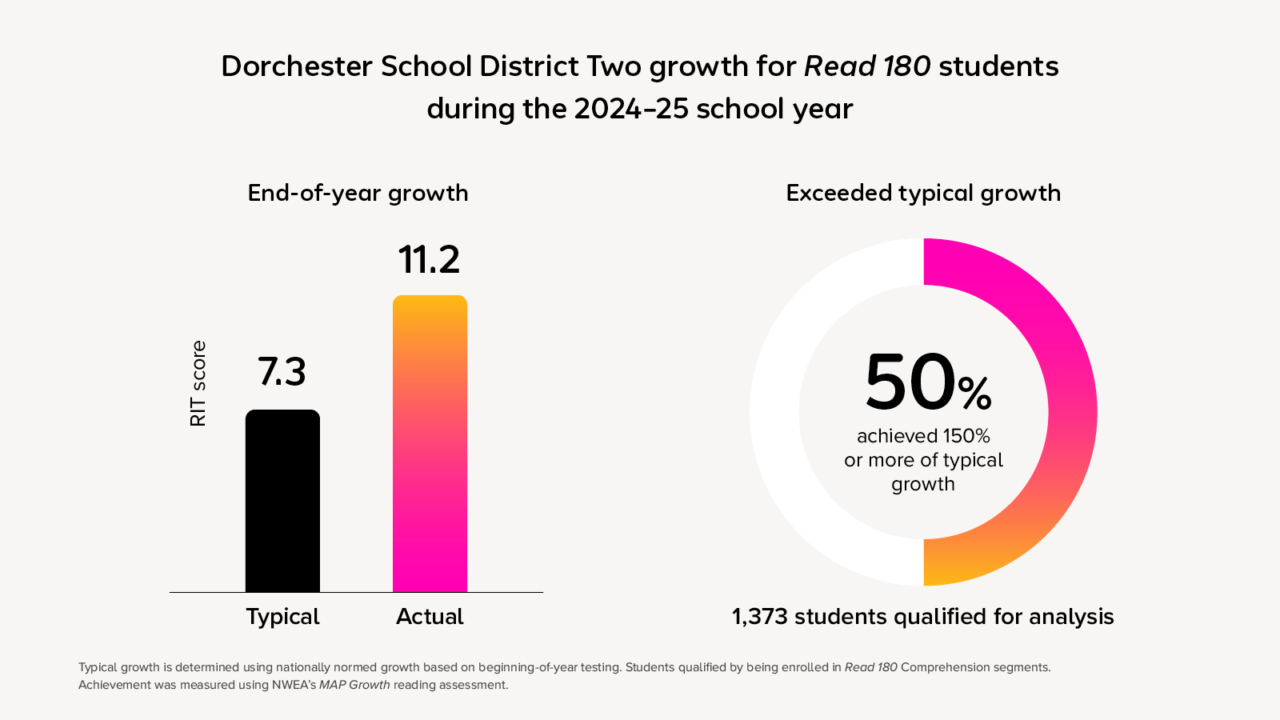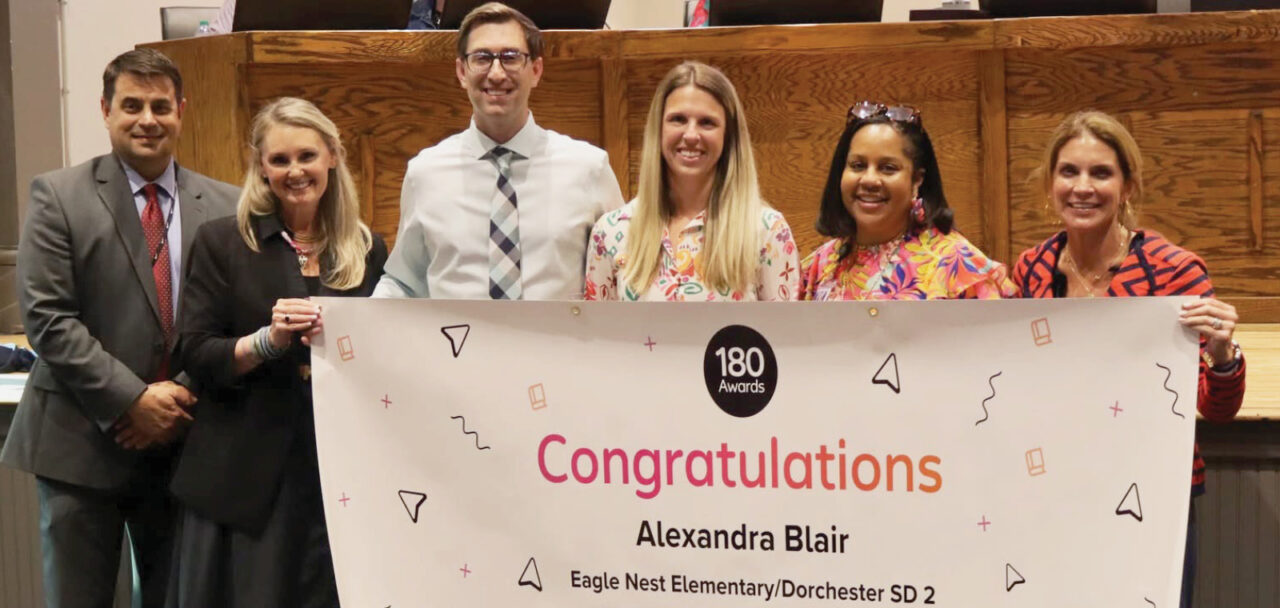
Dorchester School District Two, or DD2, is a relatively large district based in Summerville, South Carolina, a part of the country known for lush pine trees and Southern hospitality. The district is large, with around 26,000 students and 4,000 faculty and staff.
Yet around one third of the students start the year several grades behind in math and reading, a challenge that DD2 is continually prepared to meet. Every year, the administration has a laser focus on students who have fallen behind with a stated goal of bringing them up to grade-level performance. One can practically see the pride in intervention specialist Matt Moschel’s eyes: “We want to make sure that our students are going to be successful.”
A legacy of excellence
DD2 made headlines in 2022 when its superintendent Joseph Pye retired. He had been in education for 52 years, and 49 of them were with DD2. That kind of a career is a testament not only to Pye’s persistence, but also to the sense of belonging so many students and educators find in the district. “Dorchester Two is rooted in tradition,” says Carey Ball Hodge, DD2’s director of elementary schools. “We have a strong legacy of excellence and putting children first.”
Pye left behind a legacy of educational leadership that ensured no student was overlooked. Both his leadership and Chad Daugherty’s, the current superintendent and Pye’s successor, are made easier by the people they have had the opportunity to lead. The students are part of a larger community that has for years rallied around them. It’s a community where families and educators know each other. They run into each other at grocery stores and gas stations and know everyone’s names.
Intervention that works
When Joseph Pye first began approaching teachers to use Read 180, HMH’s literacy intervention program, it wasn’t a burden, it was an honor. He selected teachers who he thought would do the program justice and shared in his mission of catching students who had fallen behind up to grade level proficiency.
Ensuring that every student sees growth is a major undertaking. DD2, along with many other districts around the country, uses MTSS, or a multi-tiered system of support. This is a well-established framework that consists of three tiers of instruction:
- Tier 1: Core classroom instruction that all students receive.
- Tier 2: Additional support, often delivered in small-group settings, for students performing around one year below grade level and not responding to Tier 1 instruction.
- Tier 3: Intensive intervention support, often delivered in one-on-one settings, for students performing two or more years below grade level and not responding to Tier 2 instruction.
According to the Center on MTSS, typically only around 20% of a district’s student population requires Tier 2, or if necessary, Tier 3 interventions. Matt Moschel is DD2’s MTSS coordinator and is especially attendant to the district’s disproportionate number of students who need intervention. “My goal is to help create equity across all tiers of instruction,” says Moschel. “I'm very passionate about intervention Tier 2 and Tier 3. My ultimate goal is to see the students in Tier 2 and Tier 3 move. We want to see them move and be comfortable, confident learners in Tier 1 as a result of the support.”
Using Read 180 with fidelity
Moschel was an early Read 180 adopter himself and taught the program for 12 years before transitioning to administrative roles. The program was conceived to ensure students could see themselves in the curriculum and experience growth, no matter their current reading abilities. “ I think a lot of it has to do with the high-quality materials,” says Moschel. “Students love the articles that we read. The workshops are all very high interest.”
At DD2, educators use Read 180’s rotational model, which begins with about 20 minutes of direct whole-group learning, and then has students rotating between stations focused on independent reading, small-group learning, and the student software, each for about 20 minutes. DD2’s intervention teachers understand this approach and use it with fidelity. They lead a “twenty-first century classroom,” according to Moschel. “It’s a perfect blend of instructional software, direct instruction, and small-group instruction.”
One reason the district puts so much faith in Read 180 is that they have the numbers to back it up. The more that students use the software, the faster they grow, and they grow at a rate that outpaces many of their non–Read 180 peers.
Student achievement is monitored closely using NWEA’s MAP Growth reading assessment. At the start of the 2024–25 school year, there were 1,373 students who were placed in Read 180. Typical growth for those students would have been 7.3 points on MAP Growth’s RIT scale. However, in DD2, those students experienced on average 11.2 points of growth, over one and a half times what was expected. Around half (684) of those students exceeded typical growth by at least 150%. In addition to the district’s laudable growth, its schools have earned many national accolades over the years, including Sand Hill Elementary being named a National Blue Ribbon School and Knightsville Elementary School being recognized as a Common Sense School for Digital Citizenship.

Partners in success
HMH has for years worked alongside DD2 with their instruction. That sort of partnership between curriculum provider and school district can be critical as educators contend every year with changes to technology, policy, and of course, students. “We have been a long-time user of Read 180,” says Katie Barker, one of the district’s assistant superintendents. “One of the things that has helped us find success is the confidence that we have in HMH and knowing that even throughout change that we are going to work through it together.”
In addition to Read 180 and MAP Growth, DD2 uses several other of HMH’s high-quality instructional materials. The district has used Math 180, the math intervention equivalent to Read 180, since the program’s inception. For core curriculum, it uses Into Reading (K–5) and Into Literature (6–8) for literacy and is trying out Writable in some classrooms.
HMH recognizes this commitment and has taken part in celebrating DD2’s achievements. Every year, HMH gives 180 Awards to students and educators who use Read 180 or Math 180 and have special stories of perseverance and triumph. Nominations are submitted by people who know them, and winners are selected from around the country. DD2 routinely has multiple 180 Award winners, and even hosts their own awards ceremony where student success is cause for celebration. “We had crowds in the hallway,” says Hodge. “Everyone wanted to be interviewed. You feel like a celebrity.”
One 2025 winner was Alexandra Blair, a third-grade teacher at DD2’s Eagle Nest Elementary School. Blair has faith in Read 180’s instruction and values making data-driven decisions to ensure students receive the right instruction at the right time. She combines data from Read 180, performance data from MAP Growth, and data from students’ individual work to inform her teaching. “This resulted in 90% of her students meeting their projected goal,” says Christina Hightower, one of Blair’s colleagues, referring to their scores on MAP Growth Reading. “It truly warms my heart to see how Ms. Blair helps her students see what they are capable of.”

Along with Blair, one 2025 student winner was Eve R., an elementary student who found success with Read 180. “Eve has developed confidence,” says her teacher Dr. Yvette Clark-Blake. “When Eve attends class, she is ready to work. Eve is more outgoing and comfortable in class due to an increase in her reading comprehension and fluency.” Both Ms. Blair and Eve are now among the district’s ever-growing roster of 180 Award winners.
The importance of data
Core to DD2’s approach is a belief that a rising tide lifts all ships. When educators build the capacity for struggling students to do well, it creates a culture of growth, where all students feel the potential to master literacy and mathematics.
A culture of growth requires data showing quantifiable evidence for what teachers are striving for. Teachers may sense that students are learning the content, but it’s important to verify those assumptions using midyear and end-of-year assessments. Carey Ball Hodge, DD2’s director of elementary schools, explains how data can build teachers’ confidence. “It’s a great morale booster,” says Hodge. “When you see those results firsthand, you can’t help but to just try to duplicate that and continue on and share with your colleagues.”
The district uses NWEA’s MAP Growth assessment as the primary blueprint for student success. Achievement scores are aligned to South Carolina School Report Card indicators, helping both administrators with large school improvement efforts and teachers with individual classroom decisions. “We use the NWEA MAP data to place them in the instructional software,” says Moschel, citing one example. “There’s a lot of moving parts.” Teachers also look at real-time instructional data, curricular assessments, screening data, and a wide variety of formative and summative data to inform their instruction.
Part of the challenge with data is that it doesn’t always present what educators want to see. “Data is difficult,” says Moschel. “We want our data to be good. We want it to be strong. We want to be the shining star in the school or in the classroom. So it is hard when the data is not what you want it to be.” However, along with the power to illuminate problems, data has the power to inform solutions. Administrators can investigate data by grade level, software usage level, and other metrics, and teachers can determine precisely what to teach next. After all, DD2 is a district where students don’t just grow, they accelerate.
Teamwork and communication
Joseph Pye may no longer be the superintendent of Dorchester School District Two, but his vision lives on. Moschel continues the work that Pye started, giving careful attention to students who need it most and ensuring teachers have the tools and support they need to reach students across every tier. His expertise in Read 180 and passion for Tier 3 students in particular has made him a fierce advocate for the intervention population and a valuable partner to any district teacher looking to support students who are falling behind.
Every quarter, Moschel writes and sends out an email newsletter. “The newsletter that I create,” says Moschel, is “on-demand PD to help guide the teachers through their instruction, give them helpful hints on what to expect with the curriculum and assessments, [and] a platform to give success stories of what's happening in classrooms with the teachers and . . . students.”
The newsletter, which is also filled with photos and news and is one that intervention teachers look forward to, reveals something bigger. It shows that DD2 is a district where administrators are respected and teachers are outright revered. The end result is a community of educators who care about every student and lean on one another to help them grow. “Just wait, because it’s going to be on the map,” says Hodge. “Everyone will know where Dorchester School District Two is.”
***
Learn how Read 180 can accelerate growth of students who are reading below grade level.
Get our free reading intervention ebook today.














